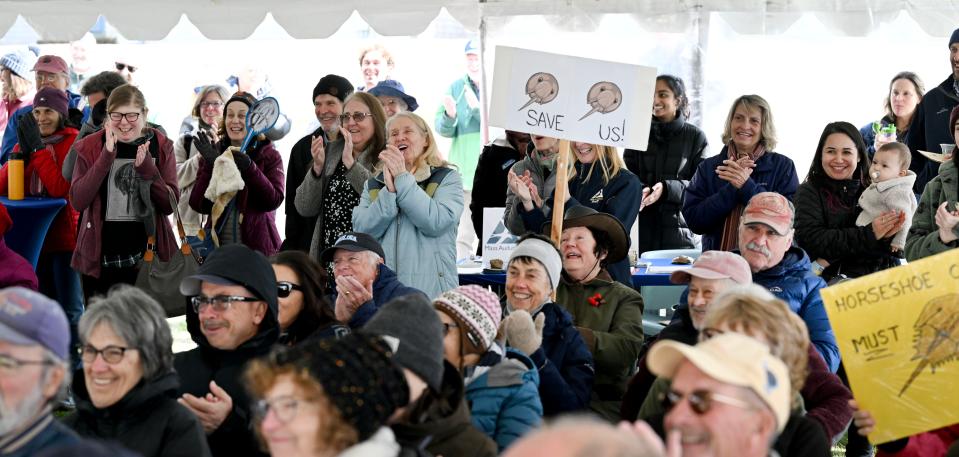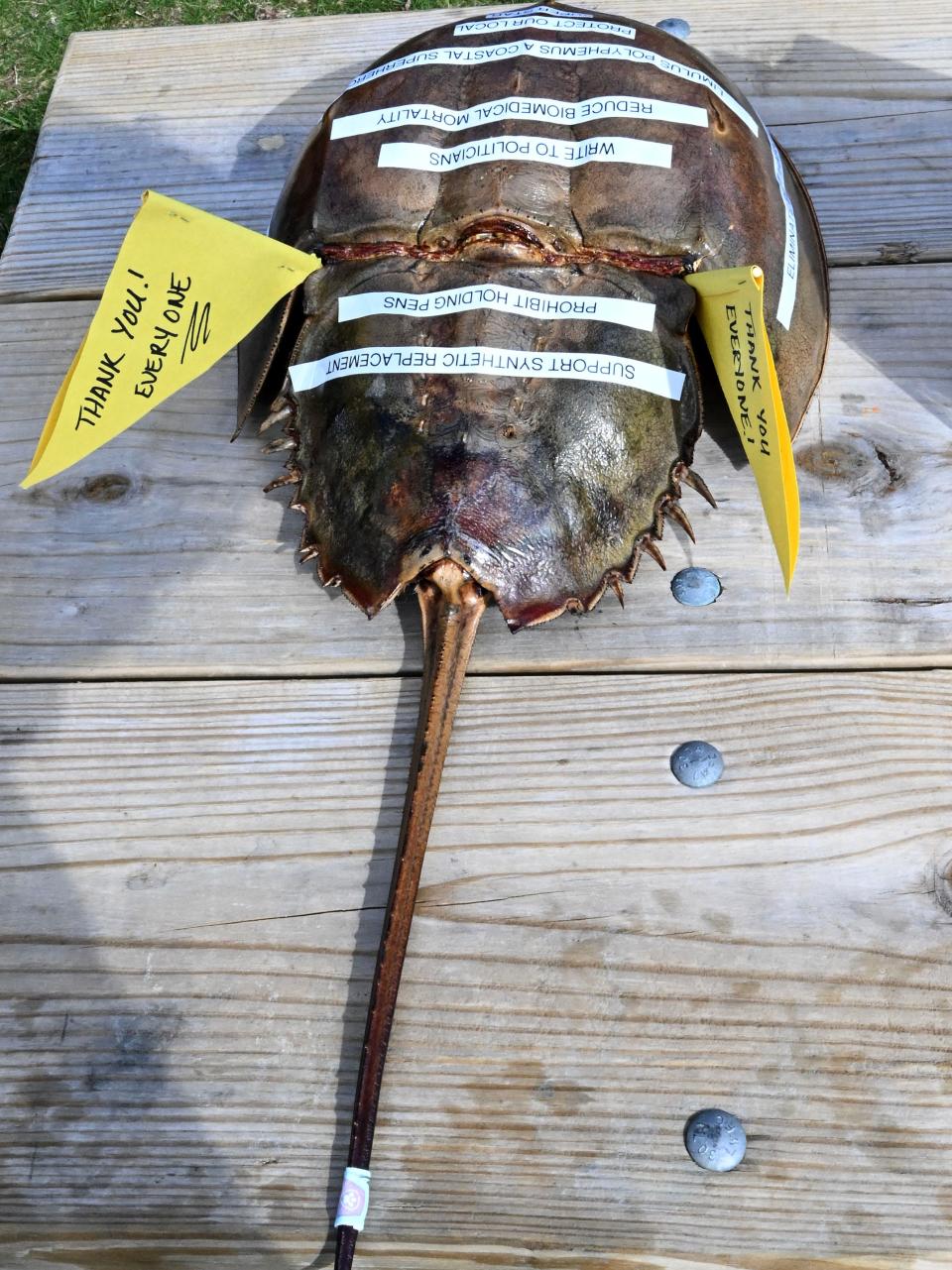Mass. increases protections for spawning horseshoe crabs. Why it matters on Cape Cod.
CUMMAQUID — In the tidal flats bordering the beach at Mass Audubon's Long Pasture Wildlife Sanctuary, where the waters of Barnstable Harbor ebb and flow through the Great Marshes behind the Sandy Neck barrier beach system, a ritual that predates the dinosaurs will soon begin.
Next month, Atlantic horseshoe crabs will begin to make their way to the shoreline here — and all over the Cape — to spawn. And this year, the event that peaks in May will take place without disturbances from harvesters, now that the Marine Fisheries Advisory Commission has adopted new regulations giving more protections to the crustaceans.
On Tuesday, an estimated 100 environmental advocates, some carrying handmade posters calling for horseshoe crab conservation, joined representatives of Mass Audubon at the wildlife sanctuary to show support for the new rules.
"What started as a demonstration ended up as a celebration," said Mass Audubon President David O’Neill Tuesday afternoon, just hours after the state commission approved more stringent rules around harvesting horseshoe crabs.

What are the new rules protecting horseshoe crabs in Massachusetts?
The commission, which works with the state Division of Marine Fisheries, voted 6-1 to adopt the regulations, changing course from a year ago when similar protections were rejected. As of Wednesday, the new rules were awaiting final approval by the Healey-Driscoll Administration.
"The new regulations protect the horseshoe crabs during their spawning season. From April 15 to June 7 every year they're no longer available for commercial harvesting," said O'Neill.
This is significant, he noted, since "that period is absolutely critical because they're spawning, they're adding to their population."
Horseshoe crab blood is used by biomedical industry
Horseshoe crabs, which are not true crabs but rather are more closely related to spiders and scorpions, are harvested for bait in the whelk and eel fisheries.
They are also collected for the biomedical industry, which "bleeds" the crabs for a protein in their blood that's used to test medical equipment and vaccines for bacteria that can make people sick or be fatal to them. Although bled crabs are returned to the ocean, 15 to 30% die as a result, according to Mark Faherty, science coordinator at Mass Audubon Wellfleet and a member of the Cape-based Horseshoe Crab Conservation Association board of directors.
Horseshoe crab populations declining on Cape Cod
Faherty said the populations on Cape Cod have been declining for years. He said he has long advocated for the state to put a stop to harvesting the crabs when they're spawning — the time when they are most vulnerable.
The decline is borne out by surveys over more than 20 years. Faherty has been involved in the studies himself for about 17 years.
"The Cape Cod Bay population is the worst. It's been very low for years, with no clear sign of recovery," Faherty said. "The areas where we see a lot of crabs are places where bait harvest is either banned or very restricted. In Pleasant Bay, Monomoy — the populations are very high there."

Female horseshoe crabs lay as many as 20,000 eggs in a single night
Some crabs may begin showing up to spawn in April, according to beach survey data from the Division of Marine Fisheries, but 90% of their spawning happens from about May 1 to June 7.
During the season, female horseshoe crabs come ashore and nudge themselves into the sand to lay nests of approximately 4,000 eggs; they may lay around 20,000 eggs in a single night, and 100,000 or more eggs over several nights, according to NOAA. The eggs are green and about the size of mustard seeds or peppercorns.
Eggs are key to coastal ecosystem
As is the case with species that lay such an abundance of eggs, most don't survive. That's because the eggs and hatchlings are also a vital food source for marine animals and shorebirds, making horseshoe crabs important to a thriving and healthy coastal ecosystem, O'Neill said.
"The horseshoe crab is a keystone species that helps a lot of other species survive," he said.
Notably, horseshoe crab eggs are an important source of nutrition for red knots, and a related subspecies called rufa red knots, which are migratory shorebirds that have historically stopped over on Cape Cod on their way between Arctic breeding grounds and nesting areas in the Gulf of Mexico and South America as far south as Tierra del Fuego. Red knots are listed as near-threatened, and rufa red knots as threatened, under the U.S. Endangered Species Act. Scientists believe much of their decline is a result of depleted horseshoe crab populations up and down the East Coast.
Ruddy turnstones, another migratory shorebird mostly seen in Monomoy and Chatham, also feed on the eggs, Faherty said.
According to the Massachusetts Department of Fish & Game, the new regulations specifically:
Prohibit all horseshoe crab harvest from April 15 – June 7 annually during peak spawning season.
Establish a uniform bait fishery trip limit of 300 horseshoe crabs per calendar day for all limited-entry horseshoe crab harvesters. The trip limit would then automatically increase to 400 crabs on Aug. 1 if 50% or more of the quota remains available, or automatically decrease to 200 crabs if 80% of the quota is taken before Sept.15.
Complement existing federal harvest prohibitions with state prohibitions within the boundaries of the Cape Cod National Seashore and the Monomoy National Wildlife Refuge.
The agency indicated in a Wednesday email that the proposed changes "will not reduce the current overall quotas of 140,000 horseshoe crabs for the bait harvest or 200,000-horseshoe crabs for biomedical purposes."
Division of Marine Fisheries Director Dan McKiernan said the new rules "bring Massachusetts protections in line with other New England states."
The new rules also catch Massachusetts up with other East Coast states that previously increased protections for horseshoe crabs, including New Jersey, Delaware and South Carolina — all also important stopovers for declining and threatened migratory birds like the red knots.
"It’s been a long road," said Faherty. "We're thankful to the Division of Marine Fisheries for bringing it back and getting it done."
Heather McCarron can be reached at hmccarron@capecodonline.com, or follow her on X @HMcCarron_CCT
Thanks to our subscribers, who help make this coverage possible. If you are not a subscriber, please consider supporting quality local journalism with a Cape Cod Times subscription. Here are our subscription plans.
This article originally appeared on Cape Cod Times: Why these Cape Codders are celebrating a new horseshoe crab ruling

